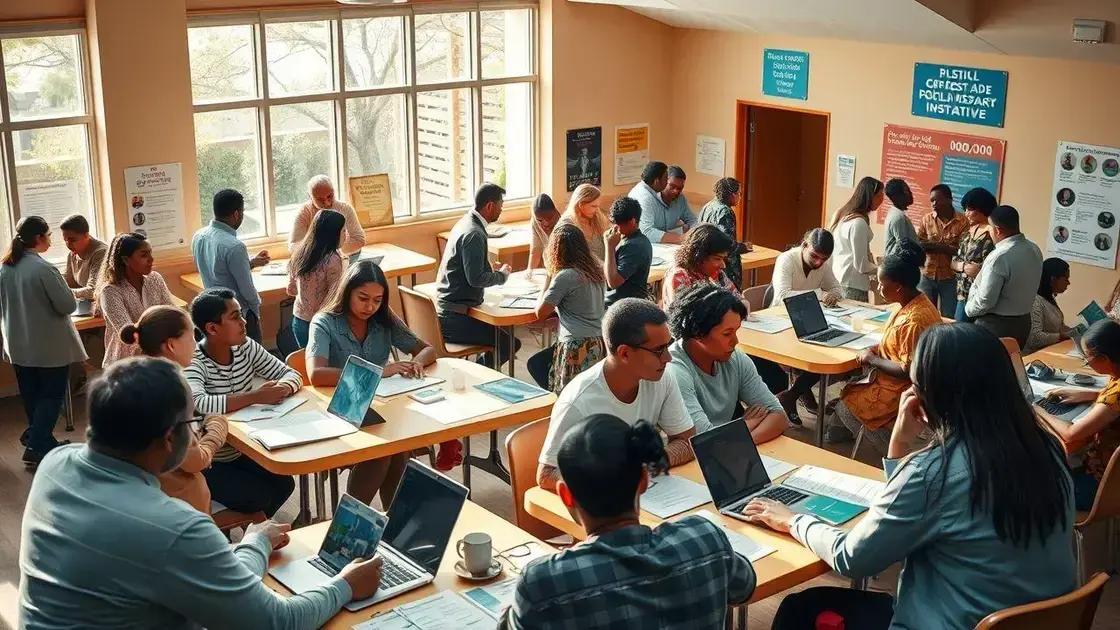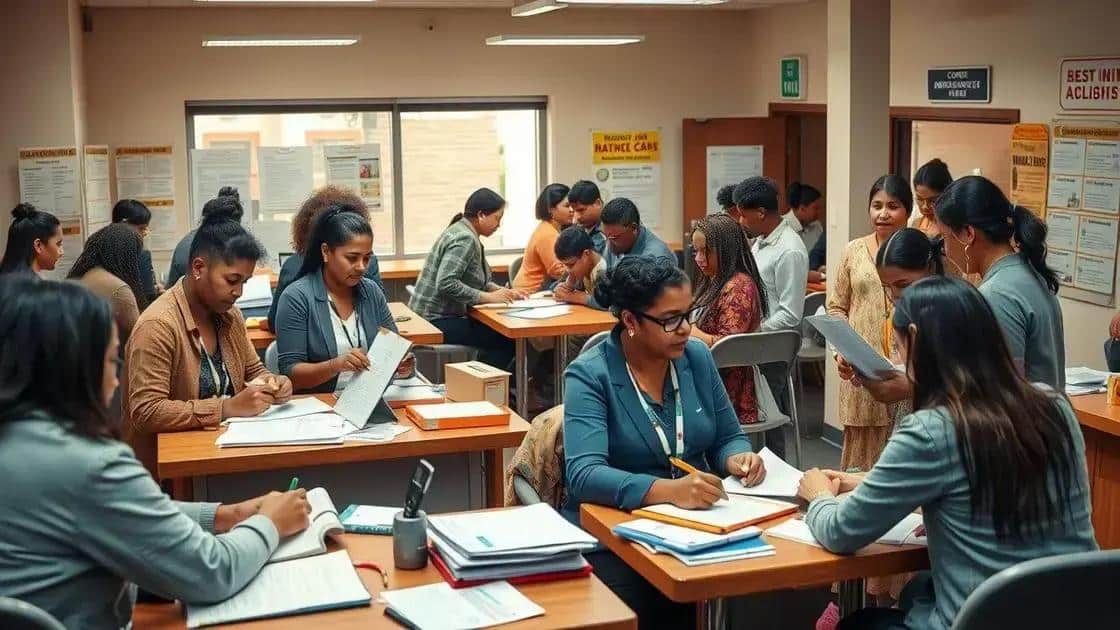Necessary public assistance access for a better life

Necessary public assistance access provides critical support for individuals facing economic hardships, enabling them to obtain food, housing, and healthcare through various available programs.
Necessary public assistance access can transform lives by providing vital support. Have you ever considered how these programs could help you or someone you know? Let’s dive into the details.
Understanding public assistance programs
Understanding public assistance programs is essential for individuals seeking help. These programs offer support to those in need and can make a significant difference in their lives. They are designed to provide financial aid, health care, and housing assistance.
Types of Public Assistance Programs
There are various types of public assistance programs, each targeting specific needs. Some of the most common programs include:
- Food assistance programs to help families afford nutritious meals.
- Cash assistance programs providing financial support to low-income individuals and families.
- Housing assistance programs that ensure safe and affordable living conditions.
- Medical assistance covering health care costs for eligible individuals.
Moreover, understanding eligibility requirements is crucial to accessing these programs. Each program has criteria that applicants must meet, often based on income, family size, and residency status. By gathering the necessary documents and information, individuals can determine whether they qualify for assistance.
How to Access These Programs
Accessing public assistance programs can seem complex, but it’s often straightforward. Many local agencies provide help in filling out applications and gathering required information. Additionally, there are online resources available that offer step-by-step guidance.
Having the right information before applying is important, as it ensures a smoother process. Many individuals may find themselves frustrated when they are not prepared. The more organized you are, the easier it will be to navigate the system. Reach out to local organizations if you have questions or need assistance.
Also, keep in mind that programs can vary significantly from one state to another. Therefore, it’s essential to research the specific assistance available in your area to maximize your benefit. Staying informed about any changes to these programs is vital, as policies can evolve over time, affecting eligibility and benefits.
The importance of access to public assistance
The importance of access to public assistance cannot be overstated. These programs play a critical role in supporting vulnerable populations and ensuring basic needs are met. Without access to these services, many individuals and families struggle to survive.
Essential Support for Basic Needs
Public assistance programs provide essential support for people facing economic hardships. This includes:
- Food assistance, which ensures families can afford healthy meals.
- Housing support that prevents homelessness and keeps families safe.
- Healthcare services that make medical care accessible and affordable.
When individuals have access to these services, they can focus on improving their situations instead of just surviving. This shift can result in healthier communities where everyone has a chance to thrive.
Economic Stability and Growth
Access to public assistance also contributes to economic stability and growth. For instance, when people receive financial support, they are more likely to spend money on local businesses, stimulating the economy. Additionally, public assistance helps to create jobs, as service providers expand to meet the needs of those seeking help.
Moreover, having a safety net reduces stress and anxiety levels. When families are not worried about daily survival, they can invest in education and career development. This upward mobility is crucial for breaking the cycle of poverty.
Access to public assistance is not just a safety net; it is a pathway to a better future. Those who receive help often find themselves in positions to help others, creating a cycle of support within communities. Therefore, understanding and prioritizing these programs is essential for fostering strong, resilient communities.
Challenges in obtaining necessary assistance

Challenges in obtaining necessary assistance can create significant barriers for those in need. Many individuals encounter obstacles that prevent them from accessing vital public aid. Understanding these challenges is the first step toward overcoming them.
Common Barriers to Access
Several common barriers can hinder access to necessary assistance. These include:
- Lack of information: Many people are unaware of the assistance available to them.
- Complex application processes: Some programs have complicated procedures that can be overwhelming.
- Eligibility requirements: Strict criteria may exclude individuals who genuinely need help.
- Stigma: Fear of judgment can discourage people from seeking assistance.
Overcoming these barriers requires targeted efforts both from organizations and individuals. Community outreach programs can help spread awareness about available resources. Simple, user-friendly applications are crucial for making the process easier for everyone.
The Role of Community Organizations
Community organizations play a vital role in assisting individuals in navigating these challenges. They provide valuable support and resources, helping connect people with the right services. These organizations often offer:
- Workshops on how to apply for assistance.
- Personalized guidance through the application process.
- Resource centers where individuals can find information about various programs.
Additionally, volunteers in these organizations can act as advocates, helping individuals understand their rights and options. This personalized assistance can drastically improve an individual’s chances of successfully obtaining necessary aid.
As communities work together to identify barriers, more effective solutions can be developed. This collaborative approach enhances the accessibility of necessary public assistance resources for everyone in need.
How to apply for public assistance
Applying for public assistance is a process that can seem daunting, but it is essential for many individuals and families in need. To effectively navigate this process, it helps to understand the steps involved.
Gather Necessary Information
Before starting your application, gather the needed documents and information. This helps streamline the application process. Essential items include:
- Identification: A government-issued ID, such as a driver’s license or passport.
- Proof of income: Recent pay stubs, tax returns, or unemployment letters.
- Household information: Details about all members living in your home.
- Expenses: Information about monthly expenses like rent, utilities, and medical bills.
Having this information ready will make the application process much smoother and faster. Once you have what you need, you can move on to the next steps.
Fill Out the Application Form
Most public assistance programs offer applications online, by mail, or in person. Choose the method that works best for you. When filling out the application:
- Be honest: Providing accurate information is crucial for the approval process.
- Double-check: Review your application to avoid any mistakes that could delay its processing.
- Submit on time: Ensure you meet any deadlines for applications.
Once your application is submitted, you will receive a confirmation, and processing will begin. You may need to provide additional information during this time, so it’s important to respond promptly.
Follow Up on Your Application
After applying, be proactive. Check the status of your application regularly. Most departments or agencies allow you to check online or by phone. If your application is denied, you have the right to appeal the decision. Knowing how to access the appeal process can be essential.
Remember, applying for public assistance is your right. The programs exist to help those in need. By following the steps and staying informed, you can successfully navigate the application process and obtain the assistance you require.
Resources for navigating the public assistance system
Resources for navigating the public assistance system are vital for individuals and families seeking support. These resources make the process of applying for and obtaining aid much more manageable.
Online Resource Guides
Many organizations provide online guides that explain how public assistance programs work. These guides often include:
- Step-by-step application procedures: Clear instructions on how to fill out forms and what documents are needed.
- Eligibility requirements: Information on who qualifies for various assistance programs.
- FAQs: Answers to common questions about public assistance and how to navigate the system.
These online resources can help individuals feel more confident when applying for aid. Being informed about the processes makes it easier to provide the right information and documents.
Local Support Centers
In-person support is also available at local community centers or social service offices. These centers often offer:
- One-on-one assistance: Staff members can help fill out applications and gather required documents.
- Workshops: Educational sessions on understanding benefits and rights related to public assistance.
- Support groups: Opportunities to connect with others who are facing similar challenges.
Utilizing local support centers can provide immediate help and answers to complex issues. Many individuals find having a person to talk to makes a significant difference in their experience.
Hotlines and Helplines
Many states have hotlines where individuals can call to get information about public assistance programs. This can be a quick way to ask specific questions and get immediate answers. These hotlines often provide:
- Direct information: Quick answers about eligibility, applications, and benefits.
- Confidential support: A safe space to discuss personal circumstances without judgment.
Making a phone call can often lead to valuable information that is not readily available online. It’s an essential resource for those who prefer speaking to someone directly.
Accessing public assistance is crucial for many individuals and families facing difficult times. By understanding the resources available, like online guides, local support centers, and hotlines, people can navigate the application process more easily. Overcoming the challenges associated with public assistance is possible, and support is available. With the right information and help, anyone can get the assistance they need to improve their quality of life.
FAQ – Frequently Asked Questions about Accessing Public Assistance
What types of assistance can I apply for?
You can apply for food assistance, cash aid, housing support, and medical assistance, depending on your needs and eligibility.
How can I find local support centers?
You can search online for community resources or contact your local government’s social services department for information.
Is there any cost associated with applying for public assistance?
No, applying for public assistance is free. You should not be charged for any services related to the application process.
What should I do if my application is denied?
If your application is denied, you can appeal the decision by contacting the appropriate agency and following their appeals process.






